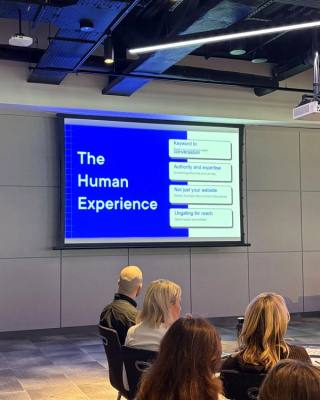As anybody who has worked on government projects over the past few years may have noticed, there is an increasing appreciation of design work within the Irish public sector.
In particular, this is reflected in the “Government of Ireland Design System”, a consolidation of guidelines to be followed in the design of any digital government project. The entire design system can be found here, and includes everything from cookie banners to page layouts. The intent, as with any design system, is to make it easy for designers and developers to mix and match components from an established library, ensuring a consistent experience for the end user.

A web page template from the Government of Ireland Design System.
At Kooba, we are long-time proponents of design systems, and this one is no exception. Here’s why:
Economies of scale
The wider the reach of a project, the more valuable a consistent design approach becomes. At Kooba, we have implemented design systems on large project suites, providing a set of resources that can be quickly deployed for building new pages, sites, or content. For an entity as large as the Irish government, a design system therefore makes a lot of sense. A forward thinking investment into building out this library will save time and money down the line, and allow for more agile and flexible reactions to issues and opportunities. It also allows for smaller projects to be undertaken off the cuff, without the need for a design team to begin from square one.
Brand consolidation
It seems strange to argue that the Irish Government has a brand, but it does. And likewise, a consistent visual identity, user experience, and tone of voice is an important element of that brand. A consolidated design system helps to provide consistency in these elements across the entire suite of government digital platforms, creating a similar “look and feel” across every website. This consistency also makes life easier for users, who will find each government website and platform easy to navigate once they become familiar with their shared layouts and components.

If these buttons from gov.ie seem familiar, it's because they are also used on many other government websites.
Integrated inclusion
Consistency matters in general, but it is particularly valuable when it comes to accessibility. By considering accessibility throughout the creation of design system layouts and components, a base of accessible assets can be compiled for designers and developers to use. Of course, complete accessibility requires more than just the assembly of accessible components. However, building these components makes life a lot easier for those who are less qualified to design accessible solutions from scratch. It also saves time for accessibility auditors, allowing them to focus on unique issues rather than churning through the same problems again and again across different sites.
Design matters
Perhaps most importantly, the creation of this design system signals a new degree of respect from the public sector for good design principles. I know designers (including myself) love to harp on about the value of their work, but it's for good reason. The strategic and considered use of design work really does make a difference, and this particular design system should make building digital solutions cheaper and faster for the Irish government.
At Kooba, we’re always looking for ways of delivering more efficient and durable solutions for clients. If you think your organisation could benefit from an improved design system (or if you want to build one from scratch!) don’t hesitate to contact our design team, we’ll be happy to walk you through the options available.









